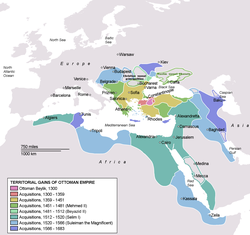Ilẹ̀-Ọba Òttómánì
Ilẹ̀-Ọba Ottomani tabi Ilẹ̀jọba Ottomani
| |||||||||||||||||||||||||||||||||||||||||||||||||||||||||||||||||||||||

|
Àyọkà yìí tàbí apá rẹ̀ únfẹ́ àtúnṣe sí. Ẹ le fẹ̀ jù báyìí lọ tàbí kí ẹ ṣàtúnṣe rẹ̀ lọ́nà tí yíò mu kúnrẹ́rẹ́. Ẹ ran Wikipedia lọ́wọ́ láti fẹ̀ẹ́ jù báyìí lọ. |
Itokasi
àtúnṣe- ↑ Finkel, Caroline, Osman's Dream, (Basic Books, 2005), 57; "Istanbul was only adopted as the city's official name in 1930..".
- ↑ The Treaty of Sèvres (August 10, 1920) afforded a small existence to the Ottoman Empire. The abolishment of the Ottoman Sultanate on November 1, 1922 did not end the Ottoman State, but only the Ottoman dynasty. The official end of the Ottoman State was declared through the Treaty of Lausanne (July 24, 1923). It recognized the new "Ankara government", and not the old Constantinople-based Ottoman government, as representing the rightful owner and successor state. The Constantinople-based government was practically headless after the sultan left the capital. The TBMM declared the successor state to be the "Republic of Turkey" (October 29, 1923).


